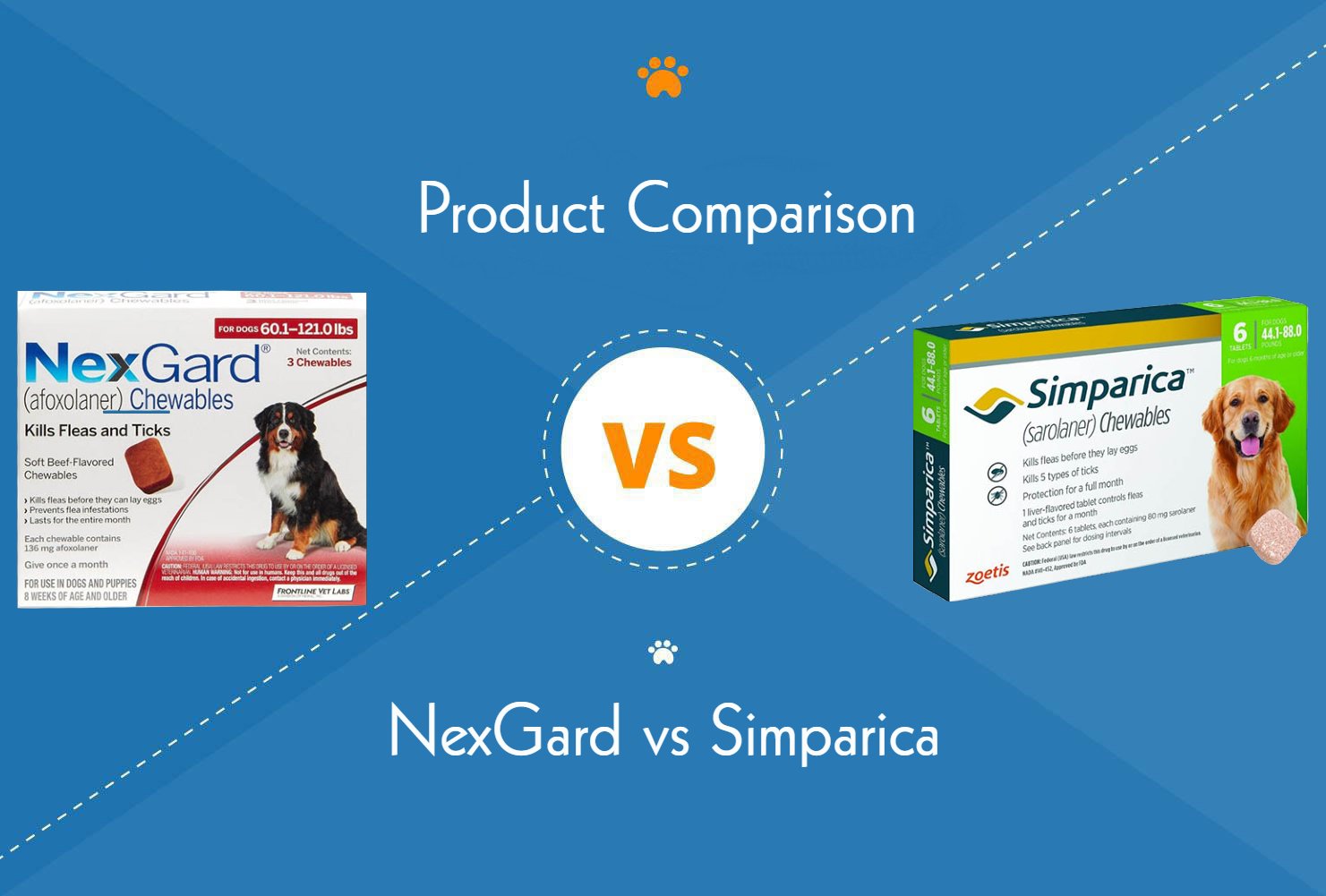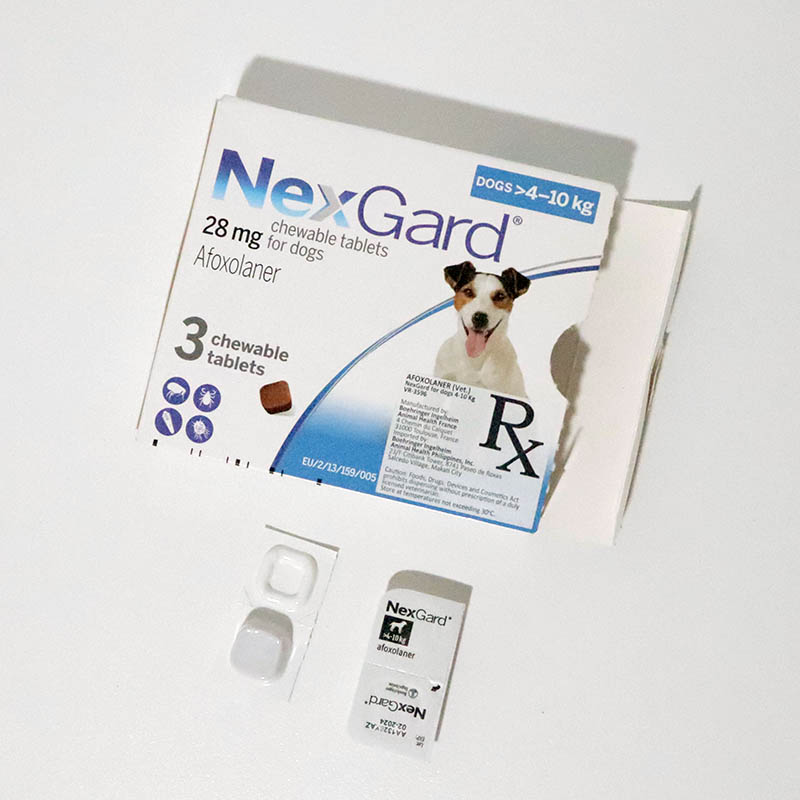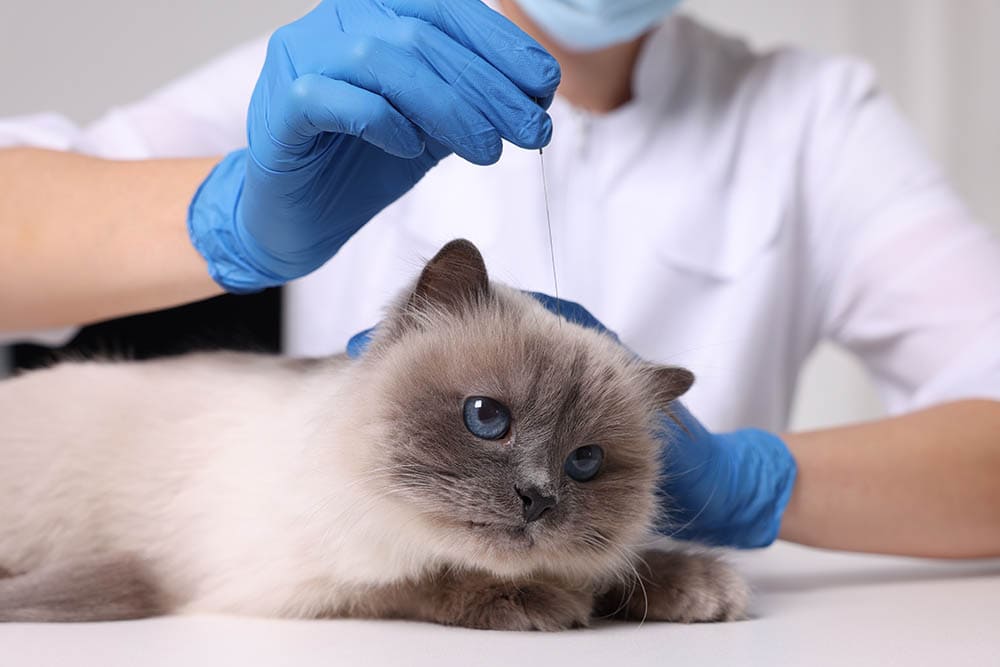NexGard vs Simparica: Vet-Explained Pros, Cons, & Differences (2024 Update)

Updated on

Click to Skip Ahead
Most pet owners are familiar with the burden of choosing and administering flea and tick treatment. Fleas and ticks cause huge problems for our pets all year round so it is important to make sure they are properly protected. There are so many products on the market, and it can be difficult for owners to know which one to choose. Two of the top products used currently are Nexgard and Simparica. They are both useful in their own unique ways, but which one is best for your dog? Here is a vet-written guide to help you decide!
Both Nexgard and Simparica are products commonly prescribed as parasite treatment for dogs. They both work against ticks, fleas, sarcoptic mange, and democratic mange. Simparica has the advantage of treating ear mite infestations too. They are both administered on a monthly basis. The treatment protocol may be altered slightly if using products to treat mites—your vet will be able to advise you on this.
Nexgard contains Afoxolaner and is made by Boeheinger Ingelheim. There are other products that have a broader spectrum of activity such as Nexgard Spectra and there is a product that is designed for use in cats, Nexgard Combo. Simparica contains Sarolaner and is made by Zoetis. A broader spectrum alternative is Simparica Trio.
The mechanism of action in both drugs is similar, they both use a pesticide from the same Isoxazoline class. They both kill parasites by acting to halt the normal functions of the parasites’ nervous system. Parasites must have bitten and been feeding from your dog for the product to work effectively.
Both products are prescription-only medications. This means your vet can prescribe them for your dog, and they have to be examined by your vet at regular intervals to ensure they are in a good state of health.
At a Glance
- Prescription-only veterinary medicine that is used on a monthly basis
- Chewable beef-flavored tablet
- Rapidly kills fleas and treats and controls ticks
- Can be used in the management of flea allergic dermatitis
- Can be used from 8 weeks of age and 2 kg bodyweight
- Exposure to the product kills adult fleas within 8 hours and ticks within 48 hours.
- Treats and controls mites and sarcoptic mange
- Prescription-only veterinary medicine that is used on a monthly basis.
- Chewable, liver-flavored tablet.
- Rapidly kills fleas and ticks.
- Can be used for the management of flea allergic dermatitis.
- Exposure to the product kills adult fleas within 8 hours and ticks within 12 hours.
- Can be used from 8 weeks of age and 1.3kg bodyweight
- Treats demodicosis and sarcoptic mange
- Can also be used for the treatment of ear mites infestation
Overview of Nexgard
- Can be given with food.
- Is normally administered with ease as it is a flavored palatable tablet that is easily chewed.
- Breaks the flea life cycle as fleas are killed before they produce eggs.
- Works quickly—kills adult fleas within 8 hours of exposure and ticks within 48 hours.
- As well as fleas and ticks, it also treats demodex mites and sarcoptic mange.
- Minimal reports of adverse reactions. Reactions that have been documented were not deemed to be serious and did not require treatment (self-limiting and of short duration).
- Safe to use in Border Collies who are known to have multidrug resistance genes and can react to certain anti-parasite products.
- It does not prevent the spread of diseases that parasites may be carrying.
- Adverse reactions have been reported including mild gastrointestinal effects such as vomiting, diarrhea, pruritus, lethargy, neurological signs, and anorexia.
- There is currently no data on the use of lactating or pregnant bitches.
- Due to the minimum age and weight, it is not suitable for certain toy breeds or younger puppies.

Overview of Simparica
- Can be given with food.
- Is normally administered with ease as is a flavored palatable tablet that is easily chewed.
- Breaks the flea life cycle as fleas are killed before they produce eggs.
- Works quickly, exposure causes death of adult fleas within 8 hours, new ticks in 12 hours and established ticks in 24 hours.
- Adverse effects are not common and have been reported in less than 1 dog in 10,000. It has been reported these signs usually resolve without treatment.
- As well as fleas, and ticks, it also treats demodex mites and sarcoptic mange.
- Known to treat ear mite infestations as well.
- Safe to use in Border Collies who are known to have multidrug resistance genes and can react to certain anti-parasite products.
- Reports of persistent flea and tick-killing activity for at least 35 days so if a dose is slightly late, the dog is still protected.
- Reported to be well tolerated in puppies from 8 weeks old and dogs weighing 1.3kg and over.
- It does not prevent the spread of diseases that parasites may be carrying
- Cannot be used in puppies under 8 weeks old.
- Has been trialed and not approved for use in breeding pregnant or lactating bitches.
- Side effects documented include vomiting and diarrhea, tremors, ataxia, and convulsions.
What Are the Differences Between Nexgard and Simparica?
At a glance, both products seem very similar, although there are some significant differences.
Performance
Edge: Simparica
Simparica has the edge here as it has a broader spectrum of activity. Simparica is active against ticks, fleas, demodex, and sarcoptes, plus species of ear mites. Nexgard is only active against ticks, fleas, demodex, and sarcoptes.
Simparica and Nexgard both kill fleas within 8 hours of them jumping on the dog and feeding. Simparica works faster on ticks, killing them within 12 hours of jumping on and feeding. Nexgard kills ticks within 48 hours of the tick attaching and feeding.
Simparica and Nexgard both have efficacy against fleas for 35 days after dosing, however, Nexgard only has effective action against ticks for 4 weeks, whereas Simparica maintains efficacy against ticks for 5 weeks, so Simparica wins this round too.
Simparica and Nexgard can be used safely in Border Collies. Some Border Collies are recognized to have a mutation of the MDR1 gene. This mutation means they are more sensitive to adverse effects from certain medications. One type of drug they are known to react to is antiparasitic medications. Nexgard is believed to be safe and effective, dogs with the MDR1 mutation were deemed to be at no greater risk for adverse effects. Simparica was well tolerated in dogs with the MDR1 gene, although it is advised that in sensitive breeds, the dose should be strictly observed.
Simparica and Nexgard can both be used in younger dogs as long as they are over 8 weeks of age. Simparica has a lower minimum weight requirement of 1.3kg compared to Nexgard which can only safely be used in dogs over 2kg.
Price
Edge: Simparica
Currently, Simparica is slightly cheaper per unit than Nexgard, however, there is not a significant price difference, and depending on how much your veterinarian practice buys in bulk of each product, this may mean they can dispense Nexgard at a lower cost.
Palatability
Edge: Tie
Some dogs may have a preference for flavor. Simparica is liver-flavored and Nexgard is beef-flavored.

Safety
Edge: Tie
It has been reported that some adverse effects were seen in puppies treated with more than the recommended dose of Simparica. This was not the case when puppies were given more than the recommended dose of Nexgard. This could be used to argue that Nexgard is safer than Simparica, however different testing methods were carried out to obtain these results so the results cannot be fairly compared. None of the adverse effects were witnessed when the correct dose of Simparica was administered.
What the Users Say
Analyzing the reviews and opinions of frequent users of Simparica and Nexgard, the general consensus is very positive for both products. Owners seem to be very satisfied with both Simparica and Nexgard.
Reviews for Simparica are generally very positive. There is mention of the flea infestation being eliminated within the number of hours stated by Zoetis. Other reviews mention they much preferred the oral treatment to the spot-ons available. There were some reviews documenting adverse effects as described, however, nothing serious was reported and no long-term chronic effects were mentioned.
Nexgard reviews were also very positive. Some owners report that their dogs look forward to the tablet and viewed it as a treat. There were a small number of reports detailing adverse reactions as described in the literature, but all seemed to be self-limiting and nothing serious was reported.
Most importantly, vets recommend both products and use them for their own pets as well as prescribing them frequently for their patients. The general consensus is that both products work as they should, are extremely effective, and have minimal side effects.
There doesn’t seem to be a strong preference between the two products reviewing public opinions.
Conclusion
There is no strong winner in this contest, both products are well respected and frequently used with good results. If ear mites are an issue, Simparica does take the edge over Nexgard.
Both products are very easy to administer. Dogs seem to enjoy the flavor and often look forward to them as a treat. There is a very small difference in cost, but it is of no great significance. Both products have positive reviews from owners and vets across the world are happy to use and prescribe both products.
If you want any further information in relation to your own dog, your vet will be able to discuss your dog’s individual case with you and advise you which product is best suited to your dog.














